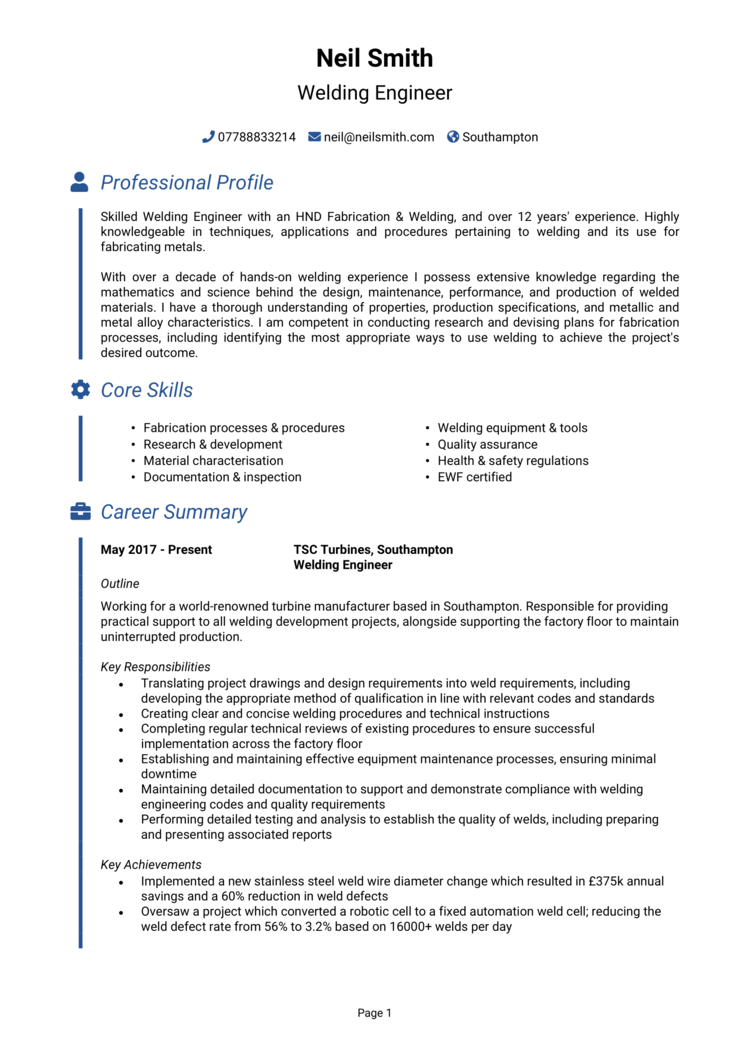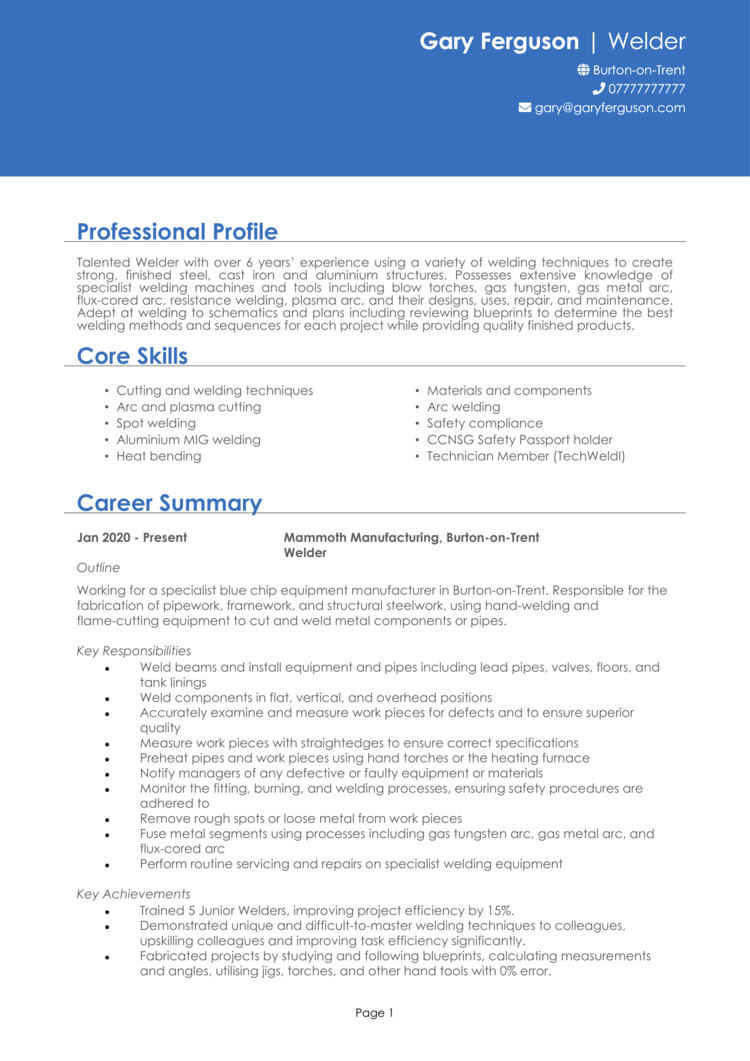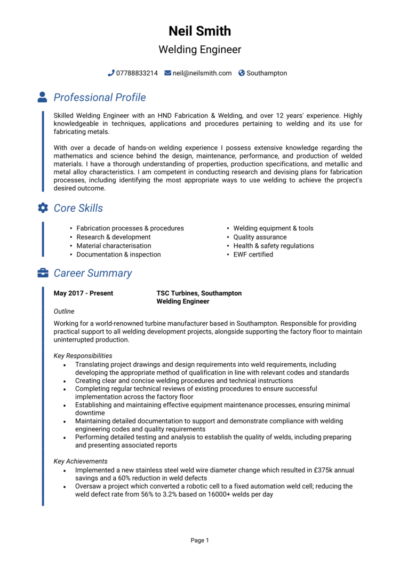Are you ready to forge your path as a Welding Engineer?
You’ll need to craft a CV that welds together your expertise and experience into something recruiters simply can’t ignore. Your CV is the blueprint like any other: it’ll need to be precise, professional, and demonstrate your best skills.
This guide, complete with 2 Welding Engineer CV examples, will show you how to structure, format, and highlight your qualifications to secure your next role.
Welding Engineer CV

Welder CV

How to write your Welding Engineer CV
Learn how to create your own interview-winning Welding Engineer CV with this simple step-by-step guide.
This guide will take you step-by-step through writing a Welding Engineer CV that highlights your technical expertise and project achievements. No matter what industry you’re aspiring towards, by the end of this guide, you’ll have everything you need to stand out.
How to structure your Welding Engineer CV


Think of it this way: your Welding Engineer CV is going to need to be as robust and well-formed as a high-quality weld. Recruiters need to see your skills and experience clearly and quickly, so a logical layout is essential to win them over.
Here’s how to structure your Welding Engineer CV:
- Name and contact details – Place your name and contact information prominently at the top of your CV for quick access. Optionally, add a photo: but it’s entirely up to you.
- CV profile – Craft a short introduction that showcases your professional background and key accomplishments.
- Core skills – Provide a quick overview of your top skills a recruiter would expect from a welder to show why you’re a great fit.
- Work experience – Walk through your professional experience, beginning with your latest position and moving backwards.
- Education – Include academic qualifications and certifications in welding and engineering.
- Additional info – You could also mention any professional memberships or specialised training, and relevant hobbies and interests to further enhance your CV.
Welding Engineer CV format


Your CV format should reflect the precision and attention to detail required in welding engineering. Plus, recruiters always appreciate a CV that’s easy to skim through. A clean, professional layout ensures recruiters can quickly grasp your expertise.
Follow these formatting tips:
- Bullet points – These let the recruiter pick out the key bits with ease.
- Divide sections – Clear headings help recruiters navigate themselves towards key information with just a glance.
- Use a clear font – A simple, professional font ensures readability while keeping the layout polished and tidy.
- Keep it the right length – 2 pages is the perfect length to cover the essentials without getting boring.
Welding Engineer CV profile


Your CV profile is your introduction to recruiters and should highlight your welding expertise, your in-depth technical knowledge, along with any noteworthy project achievements. Now’s your chance to showcase your ability to work across industries and contribute to quality and safety standards.
Welding Engineer CV profile examples
Profile 1
Experienced Welding Engineer with seven years in the oil and gas industry, specialising in pipeline construction and maintenance. Extensive expertise in welding inspections, quality assurance, and ensuring compliance with industry safety standards. Skilled in using ultrasonic testing equipment and maintaining ASME IX certification for high-pressure welding projects.
Profile 2
Proficient Welding Engineer with five years of experience in automotive manufacturing. Focused on developing welding procedures, overseeing robotic welding operations, and optimising production workflows. Adept at using SolidWorks and CAD software for design integration, ensuring precision and efficiency in production processes.
Profile 3
Dedicated Welding Engineer with over a decade of experience in structural fabrication for large-scale infrastructure projects. Expertise in arc welding, material selection, and collaborating with design teams to deliver durable, cost-effective solutions. Proficient in NDT methods, including radiographic and magnetic particle inspection, to ensure structural integrity.
What to include in your Welding Engineer CV profile
Tailor your profile to reflect the job description, emphasising skills and experiences that match the employer’s requirements.
Here’s what to include in your Welding Engineer CV profile:
- Where you’ve worked – Mention the types of industries or companies, such as construction firms or manufacturing plants, that you work in.
- Your top qualifications – Highlight certifications and or welding inspection credentials like CSWIP.
- Essential skills – Include expertise in welding techniques, quality assurance, and project management – focus on tangible, hard skills.
- Types of people you worked with – Whether you were customer-facing or worked within a larger team, make note of it here.
- Types of projects you’ve worked on – Detail specific areas, such as pipelines, structural welding, heavy machinery, or whatever it may be.
- Specialised materials you’ve worked with – Highlight expertise in welding materials like stainless steel, aluminium alloys, or high-strength steels.
- Relevant tools and standards – Reference experience with things like CAD software and ISO compliance – it’ll prove that you already grasp the role’s responsibilities.
Core skills section


And now, time to show off the toolbox of your engineering skills: at a quick glance, the core skills section will showcase the technical expertise you’re going to be bringing to the role.
For a Welding Engineer, these might include proficiency in welding inspection, knowledge of welding standards, and experience with non-destructive testing (NDT). Tailor your skills to the job, as whether it involves structural welding for construction or precision welding in aerospace will influence the most important skills to brag about.
Focus on specific, role-relevant skills rather than generic traits. For instance, instead of “good at inspections,” mention the fact that you’re “certified in ultrasonic testing for weld integrity”, for example.
Skills to include in a Welding Engineer CV
- Welding Techniques – Proficient in MIG, TIG, SMAW, and FCAW welding processes.
- Non-Destructive Testing (NDT) – Skilled in ultrasonic, radiographic, and dye penetrant testing methods.
- Welding Standards Compliance – Expertise in ISO, AWS, and ASME welding codes.
- Quality Assurance – Conducting inspections and audits to ensure weld quality and safety.
- Project Management – Leading welding projects from planning to completion within deadlines and budgets.
- Material Science – In-depth knowledge of metals, alloys, and their properties under various conditions.
- CAD Software Proficiency – Using AutoCAD and SolidWorks for design and planning.
- Welding Equipment Maintenance – Ensuring optimal performance and safety of welding tools.
- Thermal Cutting Techniques – Skilled in oxy-fuel cutting and plasma cutting.
- Team Collaboration – Coordinating with engineers, inspectors, and site managers to meet project goals.
Work experience


Your work experience section is where you’ll get to demonstrate your expertise in welding engineering. It should make up the bulk of your CV, as recruiters want to see the scale of your projects, the techniques you’ve applied, and how you’ve contributed to quality and safety standards.
List your roles in reverse chronological order, focusing on responsibilities and achievements that align with the role.
If you haven’t got much work experience, that’s fine: just emphasise certificates you’ve got or maybe some freelance projects you’ve done in the past.
How to structure jobs

- Outline – Provide an overview of the company, your role, and the type of projects you worked on while you worked there.
- Responsibilities – Highlight duties such as weld inspections and standards compliance. Use action verbs like “managed,” “inspected,” or “designed.”
- Achievements – Focus on measurable outcomes, such as reducing defects or meeting project deadlines. If at all possible, throw in some numbers here that really quantify your contributions.
Work history examples for Welding Engineers
Welder | Davison Manufacturing
Outline
Led welding operations for a mid-sized fabrication company, focusing on the construction of pressure vessels and heat exchangers. Ensured adherence to welding codes and standards while improving overall production efficiency.
Responsibilities
- Developed and qualified welding procedures in line with ASME IX standards.
- Supervised a team of 10 welders to ensure high-quality workmanship.
- Conducted visual and non-destructive testing (NDT) to verify weld integrity.
- Reviewed blueprints and specifications to plan and execute welding tasks effectively.
- Monitored consumable inventory to ensure availability and reduce downtime.
Achievements
- Improved weld quality, reducing repair rates by 20%.
- Designed a training programme that certified 8 welders to ASME standards.
- Reduced material wastage by 15% through efficient planning and execution.
Welding Engineer | Thompson Garage
Outline
Managed welding processes for a leading automotive manufacturer, focusing on the production of lightweight chassis components. Worked closely with design engineers to develop welding solutions for new product lines.
Responsibilities
- Oversaw robotic MIG and TIG welding operations for aluminium and steel components.
- Monitored weld quality using advanced ultrasonic and radiographic testing methods.
- Collaborated with R&D teams to implement innovative welding technologies.
- Conducted regular equipment maintenance and calibration to ensure reliability.
- Documented welding procedures and maintained compliance with ISO 3834 standards.
Achievements
- Reduced production defects by 18% through process optimisation.
- Implemented a new robotic welding system, increasing production efficiency by 25%.
- Achieved ISO 3834 certification for the plant within 12 months.
Welding Supervisor | Franklin Oil & Gas
Outline
Supervised welding activities for a large-scale offshore oil rig construction project. Ensured weld integrity and safety compliance in a challenging marine environment.
Responsibilities
- Managed the welding of critical structural components under strict AWS D1.1 standards.
- Coordinated daily schedules for a team of 15 welders and fitters.
- Conducted pre- and post-weld heat treatments to maintain material properties.
- Performed detailed weld inspections using magnetic particle and dye penetrant methods.
- Ensured compliance with all health and safety regulations on-site.
Achievements
- Delivered a key project milestone 10 days ahead of schedule by improving workflow.
- Reduced welding defects by 25% through rigorous quality control measures.
- Trained 6 welders in advanced offshore welding techniques, enhancing team capability.
What’s the best way to write an education section?


The education section is a relatively brief section where you’ll showcase the academic background and certifications that qualify you for the role of Welding Engineer.
Include relevant degrees in engineering and any specialised welding certifications. Ensure your qualifications are listed in reverse chronological order, starting with the most recent.
Key qualifications for a Welding Engineer
- Bachelor’s Degree in Mechanical or Materials Engineering, or a similar field
- CSWIP 3.1 Welding Inspector Certification
- TWI Diploma in Welding Technology
- ASME Section IX Certification





